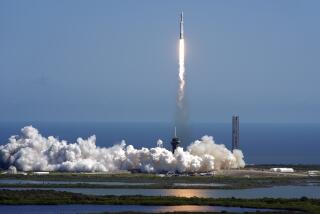Scientists Aim at Mysteries of Sun’s Polar Regions
SAN FRANCISCO — A five-year voyage by an unmanned spacecraft set for launching next May will give scientists their first look at the “unexplored regions of the sun” when it leaps out of the ecliptic plane in which the planets travel and soars around the sun’s polar regions.
“The sun does strange things (in its polar regions),” David Bohlin, project scientist with the National Aeronautics and Space Administration, told scientists attending the national convention of the American Geophysical Union here on Monday.
To accomplish its goals, the spacecraft, called Ulysses, will fly faster than any spacecraft has flown before and it will use the gravitational pull of Jupiter to fling itself out of the plane in which the planets travel, according to Peter Wenzel, project scientist for the European Space Agency.
Traveling at nearly 45,000 miles an hour, Ulysses will hook past Jupiter in 1987 and make a giant arc below the ecliptic plane, passing the south pole of the sun in March, 1990. It will continue on around the sun and pass over the north pole in early 1991, five years after launching from the space shuttle.
If Ulysses misses a three-week launch window in May, it will have to wait 13 months for Jupiter to be in the right position again to serve as a planetary sling-shot.
Ulysses is half of what was once designed as an expedition by two spacecraft--one American and one European--that were to pass over opposite poles of the sun simultaneously. The U.S. spacecraft was scratched in 1981 because of budgetary considerations, leaving only the European-built Ulysses, which will carry nine “very complex, very sophisticated instruments,” Wenzel said. Scientists from nine European countries, the United States and Canada will take part in the experiments.
Ulysses will be launched from the shuttle, but it will introduce a new generation of powerful Centaur rockets as a second-stage booster system. The powerful booster is needed to reach the high speed necessary to accomplish the mission.
Although there was considerable disappointment among American scientists when the U.S. counterpart of Ulysses was abandoned, Wenzel said the single spacecraft should be able to accomplish most of the mission’s objectives. However, the American craft was to have carried an X-ray camera, and Ulysses has no imaging equipment, so there will be no photographs of the sun’s polar regions.
Scientists have long wanted to study the sun’s polar regions, which are believed to generate high-speed solar winds that affect Earth, because those areas “ought to be quite different” from the sun’s equatorial region, Bohlin said. The poles cannot be seen from Earth, which travels in an orbit around the sun’s equator.
High-speed solar winds are thought to originate in the polar areas. Scientists hope that by studying the poles, they will better understand solar winds that affect this planet.
Other areas of substantial interest include the “corona holes,” which are less dense, cooler areas in the hot solar atmosphere that look in photographs much like holes in the sun. Far from simply being a fireball in the sky, the sun is “a very messy environment in terms of plasma physics,” Wenzel said. It is a churning, dynamic object about which surprisingly little is known, considering its importance to Earth. One reason for that lack of knowledge has been the difficulty of studying the entire sun.
It is much easier to launch spacecraft that stay in the ecliptic plane because the speed of the Earth can be used to help boost the craft into space, just as an object thrown from a moving car is affected by the speed of the vehicle. But much greater energy is needed to propel a spacecraft out of the plane on a course that is perpendicular to the orbit of the Earth.
Ulysses, which is about the size of a small car, will use a powerful rocket to reach the necessary speed, and it will pass just close enough to Jupiter to use that body’s gravity to change its course, flinging it out of its ecliptic plane.





